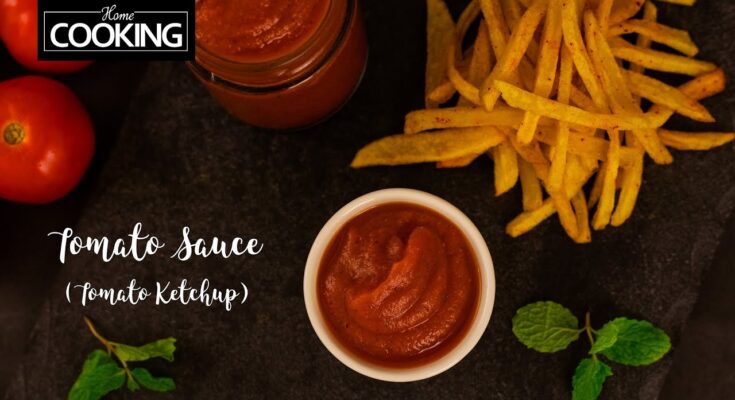Ketchup Recipe: Ketchup is one of the most beloved condiments around the world, a staple in nearly every household. It adds a tangy, slightly sweet flavor to fries, burgers, sandwiches, and even some gourmet dishes. But have you ever wondered what goes into your favorite bottle of ketchup?
Many store-bought versions contain preservatives, artificial flavors, and excessive sugar. That’s why making your own ketchup at home is a game-changer! Not only is it healthier, but you can also customize the taste to your preference. Whether you like it spicy, smoky, or mild, a homemade ketchup recipe gives you full control over the ingredients.
In this guide, I’ll walk you through a step-by-step process to create the perfect homemade ketchup, from choosing the right tomatoes to storing it properly. Let’s get started!
Ingredients Needed
To make a basic yet delicious ketchup, you’ll need the following ingredients:
Main Ingredients:
- Tomatoes (2 lbs or 1 kg) – Fresh, ripe tomatoes like Roma or San Marzano work best.
- Onion (1 medium, chopped) – Adds depth of flavor.
- Garlic (2 cloves, minced) – Provides a savory touch.
- Apple cider vinegar (½ cup) – Gives the ketchup its signature tangy taste.
- Brown sugar (¼ cup) – Balances the acidity with sweetness.
- Salt (1 tsp) – Enhances all the flavors.
- Black pepper (½ tsp) – Adds mild heat.
- Paprika (½ tsp, optional) – For a smoky undertone.
- Cinnamon (¼ tsp, optional) – Gives a warm, slightly sweet flavor.
Optional Ingredients for Variations:
- Chili powder or cayenne pepper – For a spicy kick.
- Honey or maple syrup – A natural sweetener alternative.
- Worcestershire sauce – Adds depth to the flavor.
By adjusting the ingredients, you can create a version of ketchup that suits your taste perfectly.
Tools and Equipment Required
Making homemade ketchup is easy, but having the right tools will make the process smoother:
Essential Kitchen Tools:
- Large saucepan – For cooking the tomatoes and other ingredients.
- Wooden spoon – For stirring.
- Blender or immersion blender – To achieve a smooth consistency.
- Fine-mesh strainer or cheesecloth – For removing any pulp and seeds.
- Measuring cups and spoons – For accurate ingredient proportions.
Optional Tools for a Smoother Texture:
- Food mill – Helps remove skins and seeds effortlessly.
- Glass jars with lids – For storing the ketchup properly.
Now that we have everything ready, let’s start preparing the tomatoes!
Preparing the Tomatoes
The quality of your ketchup depends on the tomatoes you use. Follow these steps for the best results:
Choosing the Right Tomatoes
- Use ripe, sweet tomatoes for the best flavor.
- Roma, San Marzano, or heirloom tomatoes are ideal.
Washing and Chopping
- Rinse the tomatoes thoroughly under cold water.
- Remove any stems and blemishes.
- Chop them into quarters for easier cooking.
Removing Seeds and Skin (Optional)
- If you prefer ultra-smooth ketchup, blanch the tomatoes in boiling water for 30 seconds, then transfer them to ice water. The skins will peel off easily.
- You can also remove seeds by pressing the chopped tomatoes through a sieve.
With the tomatoes ready, it’s time to start cooking!
Cooking the Ketchup Base
This is where the magic begins! Cooking the ingredients together brings out deep, rich flavors.
Step-by-Step Cooking Process:
- Heat the Pan – In a large saucepan, add 1 tbsp of oil over medium heat.
- Sauté the Onion and Garlic – Cook until soft and fragrant (about 5 minutes).
- Add the Tomatoes – Stir in the chopped tomatoes and let them cook for 15 minutes, stirring occasionally.
- Mix in Vinegar and Sugar – This creates the signature ketchup taste.
- Season It Up – Add salt, pepper, paprika, and any other optional spices.
- Simmer for 30 Minutes – Stir occasionally until the mixture thickens.
At this point, the ingredients have blended beautifully, and we’re ready for the next step—blending and straining!
Blending and Straining
Now that our ketchup base has simmered to perfection, it’s time to achieve that smooth, silky texture we all love.
How to Blend for a Smooth Texture
- Remove the saucepan from heat and allow the mixture to cool for about 10 minutes.
- Use a blender or immersion blender to puree the mixture until it’s smooth.
- If using a regular blender, blend in batches to avoid hot splashes.
Straining for a Refined Consistency
- For an ultra-smooth ketchup, pour the blended mixture through a fine-mesh strainer or cheesecloth into a clean saucepan.
- Use a spoon or spatula to press the mixture, extracting as much liquid as possible while leaving behind skins and seeds.
- If you prefer a chunkier ketchup, you can skip the straining step.
At this point, we have a beautiful, rich ketchup base, but it’s time to fine-tune the flavors!
Seasoning and Sweetening
Ketchup is all about balance—too much acidity or sugar can throw off the taste. Here’s how to perfect it:
Balancing Sweetness and Tanginess
- Taste the ketchup and adjust the sugar or vinegar based on preference.
- If too tangy, add a little more brown sugar or honey.
- If too sweet, balance it with extra vinegar or lemon juice.
Adjusting the Spice Level
- For a spicy ketchup, add ½ teaspoon of chili powder or cayenne pepper.
- For a smoky flavor, mix in a little smoked paprika.
- To make it extra bold, stir in a splash of Worcestershire sauce.
Once the flavor is just right, we move on to the final cooking step!
Cooking to Perfection
Now, we bring everything together by simmering the ketchup one final time.
How to Achieve the Perfect Ketchup Consistency
- Return the strained ketchup to the saucepan.
- Simmer over low heat for 20-30 minutes, stirring occasionally.
- If it gets too thick, add a little water to loosen it.
Stirring Techniques to Prevent Burning
- Use a wooden spoon to stir occasionally.
- Make sure the ketchup doesn’t stick to the bottom of the pan.
- Turn off the heat once the ketchup reaches a thick, pourable consistency.
Now that our ketchup is ready, let’s move on to storing it properly!
Storing the Homemade Ketchup
Proper storage ensures your ketchup stays fresh and flavorful.
Choosing the Right Containers
- Use sterilized glass jars or bottles for the best shelf life.
- Mason jars with airtight lids work great.
Refrigeration and Shelf Life
- Store the ketchup in the refrigerator for up to 3-4 weeks.
- For longer storage, freeze it in small portions for up to 6 months.
Now that we’ve stored our homemade ketchup, how can we use it? Let’s find out!
Serving Suggestions
Homemade ketchup is incredibly versatile! Here are some delicious ways to enjoy it:
Classic Pairings
- French Fries – The ultimate dip!
- Burgers & Hotdogs – A must-have condiment.
- Scrambled Eggs – Surprisingly delicious!
Creative Uses in Recipes
- BBQ Sauce Base – Mix with honey and mustard for an easy BBQ sauce.
- Meat Marinade – Adds tanginess to grilled chicken or beef.
- Homemade Pizza Sauce – A fun alternative to traditional tomato sauce.
Want to experiment with new flavors? Let’s explore some unique ketchup variations!
Variations and Flavor Twists
Homemade ketchup is highly customizable! Here are some unique variations:
Spicy Ketchup
- Add 1 tsp of hot sauce or ½ tsp of cayenne pepper.
Smoky Ketchup
- Use smoked paprika or a few drops of liquid smoke.
Fruity Ketchup
- Blend in pureed mango, pineapple, or apple for a sweet twist.
Feeling adventurous? Try combining multiple variations for a one-of-a-kind ketchup!
Health Benefits of Homemade Ketchup
Store-bought ketchup often contains unhealthy additives. Here’s why homemade is better:
- No Preservatives – Free from artificial chemicals.
- Lower Sugar – You control the amount of sweetness.
- No High-Fructose Corn Syrup – Many store brands use this unhealthy sweetener.
- More Nutrients – Fresh tomatoes are packed with vitamins A and C.
Now, let’s discuss some common mistakes and how to avoid them.
Common Mistakes to Avoid
Even a simple recipe like ketchup can go wrong if you’re not careful. Here are a few pitfalls to watch out for:
1. Overcooking or Undercooking
- Overcooking makes the ketchup too thick and dark.
- Undercooking leaves it too watery. Simmer for at least 30 minutes!
2. Using the Wrong Type of Tomatoes
- Watery tomatoes (like beefsteak) can result in a runny consistency.
- Stick to Roma or San Marzano tomatoes for the best texture.
3. Over-seasoning Issues
- Adding too much vinegar, sugar, or spices can ruin the balance.
- Always taste and adjust gradually.
With these tips in mind, you’ll never go wrong with homemade ketchup!
FAQs about Ketchup Recipe
What ingredients do I need to make homemade ketchup?
To make homemade ketchup, you typically need tomatoes (fresh or canned), vinegar (apple cider or white), sugar, salt, onion powder, garlic powder, and spices such as cloves, cinnamon, and allspice. Some recipes may include additional ingredients like celery salt or mustard powder for extra flavor.
How long does it take to prepare homemade ketchup?
Preparing homemade ketchup usually takes about 45 minutes to 1 hour. This includes the time needed to cook the mixture down to a thick sauce. However, the actual cooking time can vary depending on the desired thickness and the specific recipe used.
Can I make ketchup without sugar?
Yes, you can make ketchup without sugar. To create a sugar-free version, you can substitute sugar with alternatives like honey, agave nectar, or even artificial sweeteners. Keep in mind that each substitute can affect the flavor slightly, so you may need to adjust the quantities to suit your taste.
Is homemade ketchup healthier than store-bought?
Homemade ketchup can be healthier than store-bought versions as it allows you to control the ingredients and avoid preservatives and artificial additives. You can also adjust the amount of sugar and salt to make a healthier version that still satisfies your taste preferences.
How should I store homemade ketchup, and how long will it last?
Homemade ketchup should be stored in an airtight container in the refrigerator. It typically lasts for up to two weeks. For longer storage, you can freeze it in small batches and thaw as needed.
Can I can homemade ketchup for long-term storage?
Yes, you can can homemade ketchup for long-term storage. Canning involves placing the ketchup in sterilized jars and processing them in a water bath canner to seal them for shelf stability. When properly canned and sealed, homemade ketchup can last for up to a year in a cool, dark place.
Now you’re all set to make your own delicious, homemade ketchup!



